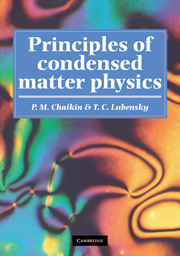Book contents
- Frontmatter
- Contents
- Preface
- 1 Overview
- 2 Structure and scattering
- 3 Thermodynamics and statistical mechanics
- 4 Mean-field theory
- 5 Field theories, critical phenomena, and the renormalization group
- 6 Generalized elasticity
- 7 Dynamics: correlation and response
- 8 Hydrodynamics
- 9 Topological defects
- 10 Walls, kinks and solitons
- Glossary
- Index
8 - Hydrodynamics
Published online by Cambridge University Press: 05 June 2012
- Frontmatter
- Contents
- Preface
- 1 Overview
- 2 Structure and scattering
- 3 Thermodynamics and statistical mechanics
- 4 Mean-field theory
- 5 Field theories, critical phenomena, and the renormalization group
- 6 Generalized elasticity
- 7 Dynamics: correlation and response
- 8 Hydrodynamics
- 9 Topological defects
- 10 Walls, kinks and solitons
- Glossary
- Index
Summary
Thermodynamics provides a description of the equilibrium states of systems with many degrees of freedom. It focuses on a small number of macroscopic degrees of freedom, such as internal energy, temperature, number density, or magnetization, needed to characterize a homogeneous equilibrium state. In systems with a broken continuous symmetry, thermodynamics can be extended to include slowly varying elastic degrees of freedom and to provide descriptions of spatially nonuniform states produced by boundary conditions or external fields. Since the wavelengths of the elastic distortions are long compared to any microscopic length, the departure from ideal homogeneous equilibrium is small. In this chapter, we will develop equations governing dynamical disturbances in which the departure from ideal homogeneous equilibrium of each point in space is small at all times.
Conserved and broken-symmetry variables
Thermodynamic equilibrium is produced and maintained by collisions between particles or elementary excitations that occur at a characteristic time interval τ. In classical fluids, τ is of order 10−10 to 10−14 seconds. In low-temperature solids or in quantum liquids, τ can be quite large, diverging as some inverse power of the temperature T. The mean distance λ between collisions (mean free path) of particles or excitations is a characteristic velocity v times τ. In fluids, v is determined by the kinetic energy, v ~ (T/m)½, where m is a mass. In solids, v is typically a sound velocity. Imagine now a disturbance from the ideal equilibrium state that varies periodically in time and space with frequency ω and wave number q.
- Type
- Chapter
- Information
- Principles of Condensed Matter Physics , pp. 417 - 494Publisher: Cambridge University PressPrint publication year: 1995

